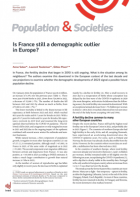The nineteenth century—of urbanization, industrialization and the demographic transition—marked a turning point for the population of France. Fertility began falling in the country as early as the mid-eighteenth century, making it a precursor in this emerging trend, but it was in the capital that births fell most. Urban development and Haussmann’s massive renovation programme, heavy immigration flows and socioeconomic transformations: the city’s response to the radical changes occurring throughout the century was a Malthusian position on fertility.
At a number of different scales—quartier (neighbourhood) and arrondissement, Paris proper and immediately outlying towns—Sandra Brée measures and analyses not only legitimate but also “illegitimate” fertility, i.e., children born out of wedlock or in free unions, capturing city dwellers’ demographic behaviours in all their complexity, particularly as shaped by their social, marital and geographic situations.
This historical study thus reveals a fascinating demographic laboratory. Parisians’ contraceptive behaviours, strongly anticipatory, were nothing short of revolutionary. In this area, too, the capital asserted a will for emancipation early on.












